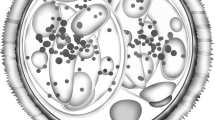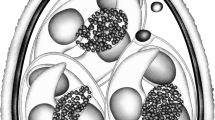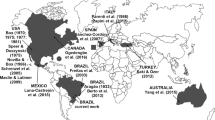Abstract
Background
Coccidia are obligatory intracellular parasites with at least one intestinal phase in their life cycles, being Isospora Schneider, 1881 the main coccidian genus related to the order Passeriformes. However, there is no record of isosporans from the passerine family Tityridae, which is the family of the greenish schiffornis Schiffornis virescens (Lafresnaye, 1838).
Purpose
This study aimed to examine the faeces from a greenish schiffornis S. virescens captured in the Itatiaia National Park, State of Rio de Janeiro, Southeastern Brazil, to determine what coccidian parasites were present.
Methods
Only one specimen of Schiffornis virescens was captured with mist nets. Coccidian oocysts were recovered from the fecal samples by flotation in Sheather’s saturated solution. Morphological observations, line drawings, photomicrographs and measurements were made in optical microscopy and digitally edited. The molecular analysis included the study of the sequence of the mitochondrial cytochrome c oxidase subunit 1 (COI) gene, with phylogenetic reconstructions based on the Neighbor-Joining and Maximum Likelihood analysis.
Results
An Isospora sp. considered as new to science is described and identified from Schiffornis virescens (Lafresnaye, 1838). Isospora oliveirai n. sp. has oocysts that are subspheroidal, 26.0 × 24.8 μm, with rough, bilayered wall, c.2.5 μm thick. Micropyle and oocyst residuum absent, but one to six polar granules are present. Sporocysts lemon-shaped, 18.1 × 10.9 μm. The Stieda body is knob-like to half-moon-shaped and sub-Stieda is rounded. Sporocyst residuum is present, composed of scattered spherules of different sizes. Sporozoites are vermiform, with refractile bodies and nucleus. Molecular analysis at the COI gene exhibited similarity of 97% with Isospora serinuse Yang, Brice, Elliot et Ryan, 2015 from island canaries Serinus canaria (Linnaeus, 1758), and Isospora spp. from great tits Parus major (Linnaeus, 1758) and European robins Erithacus rubecula (Linnaeus, 1758).
Conclusion
Based on the morphological and molecular features, I. oliveirai is considered as new to science and the first coccidian species recorded from Tityridae.



Similar content being viewed by others
References
Fayer R (1980) Epidemiology of protozoan infection the coccidia. Vet Parasitol 6:75–103. https://doi.org/10.1016/0304-4017(80)90039-4
Ruggiero MA, Gordon DP, Orrell TM, Bailly N, Bourgoin T, Brusca RC, Cavalier-Smith T, Guiry MD, Kirk PM (2015) Correction: a higher level classification of all living organisms. PLoS ONE 10:e0130114. https://doi.org/10.1371/journal.pone.0119248
Duszynski DW, Couch L, Upton SJ (2000) The coccidia of the World. https://www.k-state.edu/parasitology/worldcoccidia. Accessed 01 Feb 2020
Berto BP, Flausino W, McIntosh D, Teixeira-Filho WL, Lopes CWG (2011) Coccidia of New World passerine birds (Aves: Passeriformes): a review of Eimeria Schneider, 1875 and Isospora Schneider, 1881 (Apicomplexa: Eimeriidae). Syst Parasitol 80:159–204. https://doi.org/10.1007/s11230-011-9317-8
Berto BP, Lopes CWG (2013) Distribution and dispersion of Coccidia in wild passerines of the Americas. In: Ruiz L, Iglesias L (eds) Birds: evolution and behavior, breeding strategies, migration and spread of disease. Nova Science Publishers, New York, pp 47–66
Stotz DF, Fitzpatrick JW, Parker TA III, Moskovits DK (1996) Aves neotropicais: ecologia e conservação. Universidade de Chicago Press, Chicago
Anjos L, Collins CD, Holt RD, Volpato GH, Mendonça LB, Lopes EV, Boçon R, Bisheimer MV, Serafini PP, Carvalho J (2011) Padrões de ocupação de abundância de espécies de aves e sensibilidade à fragmentação florestal: implicações para conservação no brasileiro Mata Atlântica. Biol Conserv 144:2213–2222. https://doi.org/10.1016/j.biocon.2011.05.013
Sigrist T (2014) Guia de Campo: Avifauna Brasileira. Avis Brasilis, São Paulo
Massey JG (2003) Diseases and management of wild Passeriformes. Semin Avian Exot Pet Med 12:29–36. https://doi.org/10.1053/saep.2003.127876
Atkinson CT, Thomas NJ, Hunter DB (2008) Parasitic diseases of wild birds. Wiley-Blackwell, Singapore
ICMBIO (2018) Parque Nacional do Itatiaia. http://www.icmbio.gov.br/parnaitatiaia. Accessed 23 Feb 2020
Silva LM, Rodrigues MB, Lopes BB, Berto BP, Luz HR, Ferreira I, Lopes CWG (2016) A new coccidian, Isospora parnaitatiaiensis n. sp. (Apicomplexa, Eimeriidae), from the white-shouldered fire-eye Pyriglena leucoptera (Passeriformes, Thamnophilidae) from South America. Parasitol Res 115:745–749. https://doi.org/10.1007/s00436-015-4798-z
Pinho IF, Rodrigues MB, Silva LM, Lopes BB, Oliveira MS, Ferreira MA, Cardozo SV, Luz HR, Ferreira I, Lopes CWG, Berto BP (2017) Characterization and distribution of Isospora sabiai n. sp. (Apicomplexa: Eimeriidae) from thrushes Turdus spp. (Passeriformes: Turdidae) from Brazil. J Parasitol 103:285–291. https://doi.org/10.1645/16-152
Pinho IF, Silva LM, Rodrigues MB, Lopes BB, Oliveira, Luz HR, Ferreira I, Lopes CWG, Berto BP (2018) Isospora machadoae sp. nov. (Protozoa: Apicomplexa: Eimeriidae), a new coccidian species from white-necked thrushes Turdus albicolis (Passeriformes: Turdidae) of South America. Zoologia 35:e24570. https://doi.org/10.3897/zoologia.35.e24570
Silva-Carvalho LM, Oliveira JLG, Oliveira MS, Rodrigues MB, Abreu ST, Ortúzar-Ferreira CN, Franco HA, Thode-Filho S, Oliveira AA, Lima VM, Ferreira I, Berto BP (2019) Isospora borbai n. sp. (Chromista: Apicomplexa: Eimeriidae) from gnateaters Conopophaga spp. (Passeriformes: Tyranni: Conopophagidae) in South America. Acta Parasitol 64:6117–6624. https://doi.org/10.2478/s11686-019-00079-z
Duszynski D, Wilber P (1997) A guideline for the preparation of species descriptions in the Eimeriidae. J Parasitol 83:333–336. https://doi.org/10.2307/3284470
Berto BP, McIntosh D, Lopes CWG (2014) Studies on coccidian oocysts (Apicomplexa: Eucoccidiorida). Rev Bras Parasitol Vet 23:1–15. https://doi.org/10.1590/S1984-29612014001
Dolnik OV, Palinauskas V, Bensch S (2009) Individual oocysts of Isospora (Apicomplexa: Coccidia) parasites from avian faeces: from photo to sequence. J Parasitol 95:169–174. https://doi.org/10.1645/GE-1873.1
Yang R, Brice B, Elliot A, Ryan U (2015) Isospora serinuse n. sp. (Apicomplexa: Eimeriidae) from a domestic canary (Serinus canaria forma domestica) (Passeriformes: Fringillidae) in Western Australia. Exp Parasitol 159:59–66. https://doi.org/10.1016/j.exppara.2015.08.020
Tamura K, Dudley J, Nei M, Kumar S (2007) MEGA4: molecular evolutionary genetics analysis (MEGA) software version 4.0. Mol Biol Evol 24:1596–1599. https://doi.org/10.1093/molbev/msm092
ICZN (2012) International Commission on Zoological Nomenclature: amendment of articles 8, 9, 10, 21 and 78 of the International Code of Zoological Nomenclature to expand and refine methods of publication. Bull Zool Nomencl 69:161–169. https://doi.org/10.21805/bzn.v69i3.a8.161
Trefancová A, Kvičerová J (2019) Isospora svecica sp. n. (Apicomplexa: Eimeriidae), a new species of coccidium from the white-spotted bluethroat Luscinia svecica cyanecula (Aves: Passeriformes: Muscicapidae). Parasitol Res 118:3043–3051. https://doi.org/10.1007/s00436-019-06397-5
Piacentini VQ, Aleixo A, Agne CE, Maurício GN, Pacheco JF, Bravo GA, Brito GRR, Naka LN, Olmos F, Posso S, Silveira LF, Betini GS, Carrano E, Franz I, Lees AC, Lima LM, Pioli D, Schunck F, Amaral FR, Bencke GA, Cohn-Haft M, Figueiredo LFA, Straube FC, Cestari E (2015) Annotated checklist of the birds of Brazil by the Brazilian Ornithological Records Committee/Lista comentada das aves do Brasil pelo Comitê Brasileiro de Registros Ornitológicos. Rev Bras Ornitol 23:90–298
Dolezalová M, Torres J, Fernández H, Modrý D (2004) Isospora araponga sp. n. (Apicomplexa: Eimeriidae), a new species of Isospora Schneider from a bare-throated bellbird, Procnias nudicollis (Vieillot, 1817) (Passeriformes: Cotingidae) from Brazil. Mem Inst Oswaldo Cruz 99:829–830. https://doi.org/10.1590/S0074-02762004000800008
Berto BP, Flausino W, Luz HR, Ferreira I, Lopes CWG (2009) Isospora mionectesi sp. nov. (Apicomplexa, Eimeriidae) from the grey-hooded flycatcher, Mionectes rufiventris in Brazil. Acta Parasitol 54:301–304. https://doi.org/10.2478/s11686-009-0053-z
Berto BP, Luz HR, Flausino W, Ferreira I, Lopes CWG (2009) New species of Eimeria Schneider, 1875 and Isospora Schneider, 1881 (Apicomplexa: Eimeriidae) from the short-crested flycatcher Myiarchus ferox (Gmelin) (Passeriformes: Tyrannidae) in South America. Syst Parasitol 74:75–80. https://doi.org/10.1007/s11230-009-9197-3
Rodrigues MB, Silva LM, Lopes BDB, Berto BP, Luz HR, Ferreira I, Lopes CWG (2015) A new species of Isospora Schneider, 1881 (Apicomplexa: Eimeriidae) from the grey-hooded attila Attila rufus Vieillot, 1819 (Passeriformes: Tyrannidae) on the Marambaia Island, Brazil. Zootaxa 4034:193–196. https://doi.org/10.11646/zootaxa.4034.1.10
Silva-Carvalho LM, Pastura DGN, Gomes JV, Siqueira PB, Rodrigues MB, Lima VM, Berto BP (2018) Isospora lopesi n. sp. (Protozoa: Apicomplexa: Eimeriidae) from the eastern white-throated spadebill Platyrinchus mystaceus Vieillot (Passeriformes: Tyranni: Tyrannidae) in South America. Syst Parasitol 95:455–463. https://doi.org/10.1007/s11230-018-9795-z
Acknowledgements
We are thankful to staff at the Parque Nacional do Itatiaia, mainly to the research coordinator Dr. Léo Nascimento, that allowed us to access and use some facilities during the expeditions.
Funding
This study was supported by Conselho Nacional de Desenvolvimento Científico e Tecnológico (CNPq), Coordenação de Aperfeiçoamento de Pessoal de Nível Superior (CAPES) and Fundação Carlos Chagas Filho de Amparo à Pesquisa do Estado do Rio de Janeiro (FAPERJ). CNO-F has a scholarship from CNPq (Grant/Award number 120107/2018-0). JLG-O and MSO have scholarship from CAPES (Grant/Award number 001). BPB has a fellowship from CNPq (Grant/Award number 303899/2019-0) and from FAPERJ (Grant/Award number E-26/202.797/2019).
Author information
Authors and Affiliations
Contributions
The study was designed by VML, IF and BPB. Field work was performed by CNO-F, JLG-O, MSO, ST-F and BPB. Laboratory procedures for maintenance, recovery, measurements, photomicrographs and isolation of oocysts were performed by CNO-F and MSO. DNA extraction, amplification and sequencing were performed by CNO-F, JLG-O, ERM, AAO and VML. BPB analyzed the data and drew the coccidian oocyst. The manuscript was written by CNO-F and BPB and subsequently revised by all other authors.
Corresponding author
Ethics declarations
Conflict of Interest
The authors declare that they have no conflict of interest.
Ethical Approval
Field-collecting permits were issued by SISBIO/ICMBio (license 54951-1) and CEUA/IV/UFRRJ (protocol 6606250616). All applicable institutional, national and international guidelines for the care and use of animals were followed.
Additional information
Publisher's Note
Springer Nature remains neutral with regard to jurisdictional claims in published maps and institutional affiliations.
Rights and permissions
About this article
Cite this article
Ortúzar-Ferreira, C.N., Genovez-Oliveira, J.L., de Souza Oliveira, M. et al. Isospora oliveirai n. sp. (Chromista: Miozoa: Eimeriidae) from the Greenish Schiffornis Schiffornis virescens (Lafresnaye, 1838) (Passeriformes: Tyranni: Tityridae) in South America. Acta Parasit. 65, 843–851 (2020). https://doi.org/10.1007/s11686-020-00237-8
Received:
Accepted:
Published:
Issue Date:
DOI: https://doi.org/10.1007/s11686-020-00237-8




